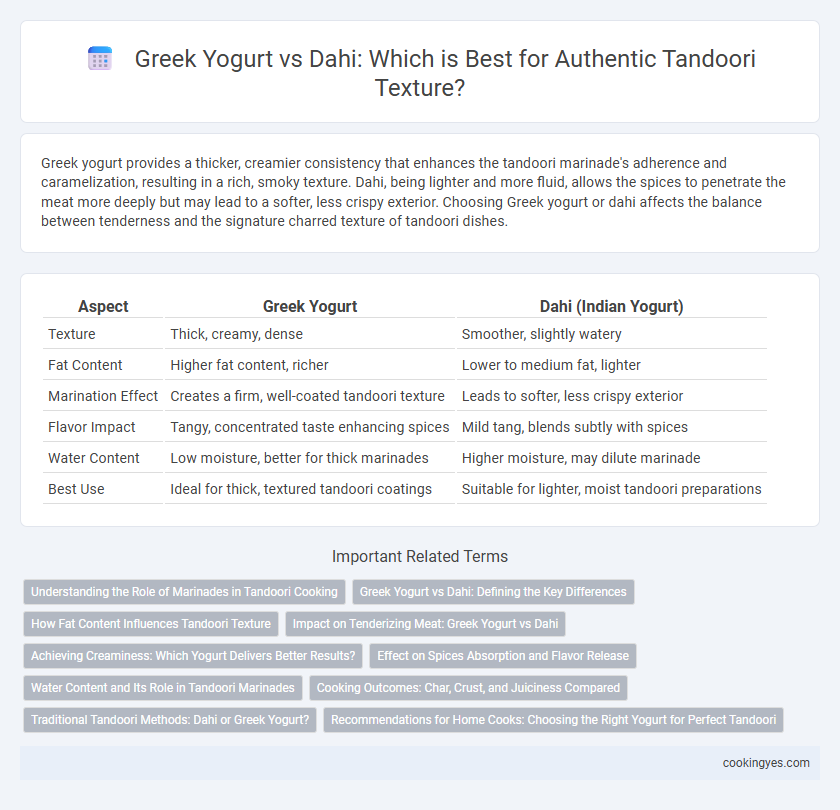Greek yogurt provides a thicker, creamier consistency that enhances the tandoori marinade's adherence and caramelization, resulting in a rich, smoky texture. Dahi, being lighter and more fluid, allows the spices to penetrate the meat more deeply but may lead to a softer, less crispy exterior. Choosing Greek yogurt or dahi affects the balance between tenderness and the signature charred texture of tandoori dishes.
Table of Comparison
| Aspect | Greek Yogurt | Dahi (Indian Yogurt) |
|---|---|---|
| Texture | Thick, creamy, dense | Smoother, slightly watery |
| Fat Content | Higher fat content, richer | Lower to medium fat, lighter |
| Marination Effect | Creates a firm, well-coated tandoori texture | Leads to softer, less crispy exterior |
| Flavor Impact | Tangy, concentrated taste enhancing spices | Mild tang, blends subtly with spices |
| Water Content | Low moisture, better for thick marinades | Higher moisture, may dilute marinade |
| Best Use | Ideal for thick, textured tandoori coatings | Suitable for lighter, moist tandoori preparations |
Understanding the Role of Marinades in Tandoori Cooking
Greek yogurt offers a thicker consistency and higher protein content compared to traditional dahi, resulting in a more robust marinade that enhances the tandoori texture by tenderizing meat effectively. Dahi's natural acidity and moisture content aid in gentle fermentation, ensuring a softer, juicier outcome while maintaining authentic flavor profiles essential in tandoori dishes. The choice between Greek yogurt and dahi directly influences marinade penetration and the final char, highlighting their distinct roles in optimizing tandoori texture and taste.
Greek Yogurt vs Dahi: Defining the Key Differences
Greek yogurt offers a thicker, creamier texture compared to traditional dahi, making it ideal for achieving a rich and smooth coating in tandoori recipes. Dahi contains more moisture and a lighter consistency, which allows for better marination but can result in a less intense glaze. The higher protein content in Greek yogurt also contributes to enhanced caramelization and a robust tandoori crust.
How Fat Content Influences Tandoori Texture
Higher fat content in Greek yogurt contributes to a creamier, richer tandoori texture by enhancing moisture retention during cooking, which helps tenderize the meat. In contrast, dahi with lower fat content results in a lighter texture but can cause the tandoori to be less succulent and slightly drier. Fat plays a crucial role in marinating by emulsifying spices and ensuring even coating, directly impacting the final tenderness and juiciness of tandoori dishes.
Impact on Tenderizing Meat: Greek Yogurt vs Dahi
Greek yogurt's thicker texture and higher protein content contribute to a creamier marinade, enhancing the tenderizing effect on tandoori meat by breaking down muscle fibers more effectively. Dahi, with its slightly thinner consistency and natural lactic acid, also tenderizes meat well but may produce a less rich coating, affecting the final texture and juiciness. Using Greek yogurt in tandoori marinades results in a more succulent and tender bite due to its superior moisture retention and enzymatic activity compared to dahi.
Achieving Creaminess: Which Yogurt Delivers Better Results?
Greek yogurt, with its thicker consistency and higher protein content, delivers a creamier texture ideal for tandoori marinades, enhancing moisture retention and flavor absorption in the meat. Dahi, though lighter and more liquid, offers a tangy profile that breaks down proteins effectively but may result in a less rich coating compared to Greek yogurt. For achieving optimal creaminess and a velvety texture in tandoori dishes, Greek yogurt is generally preferred due to its dense, creamy structure that clings well to the marinade.
Effect on Spices Absorption and Flavor Release
Greek yogurt's thicker consistency enhances spices absorption in tandoori marinades, allowing flavors like cumin, coriander, and garam masala to penetrate deeper into the meat. Dahi, being slightly thinner, creates a lighter coating that releases spices more subtly during cooking, resulting in a milder flavor profile. The higher protein content in Greek yogurt also aids in tenderizing the meat while intensifying the aromatic flavors characteristic of tandoori dishes.
Water Content and Its Role in Tandoori Marinades
Greek yogurt typically contains less water than traditional dahi, resulting in a thicker marinade that clings better to meat surfaces for enhanced tandoori texture. The lower water content in Greek yogurt reduces moisture loss during cooking, promoting a tender and juicy outcome with well-defined charred edges. In contrast, dahi's higher water content can lead to a thinner marinade, which may cause more steam and less crispness in tandoori preparations.
Cooking Outcomes: Char, Crust, and Juiciness Compared
Greek yogurt's thick consistency creates a robust crust with more pronounced charring, enhancing the smoky flavor of tandoori dishes. Dahi, being thinner and more acidic, yields a softer crust and retains greater juiciness, resulting in a tender texture. The protein content in Greek yogurt contributes to a firmer char, while dahi's moisture content helps maintain succulent meat during cooking.
Traditional Tandoori Methods: Dahi or Greek Yogurt?
Traditional tandoori methods favor dahi over Greek yogurt due to its thinner consistency, which allows better marination and deeper spice penetration in the meat. Dahi's natural fermentation process contributes to tenderizing the protein more effectively, preserving the authentic texture and smoky flavor of tandoori dishes. Greek yogurt's thicker texture can hinder the marinade's absorption, leading to a less characteristic tandoori result.
Recommendations for Home Cooks: Choosing the Right Yogurt for Perfect Tandoori
Greek yogurt's thicker consistency provides a richer, creamier marinade ideal for achieving tender, juicy tandoori chicken with a slightly tangy flavor. Dahi, or traditional Indian yogurt, offers a lighter texture and milder taste that penetrates meat well but may require longer marination for optimal texture. Home cooks should opt for Greek yogurt when seeking a robust marinade that clings well, while dahi is preferable for a subtler essence and softer finish in tandoori recipes.
Greek Yogurt vs Dahi for tandoori texture Infographic

 cookingyes.com
cookingyes.com